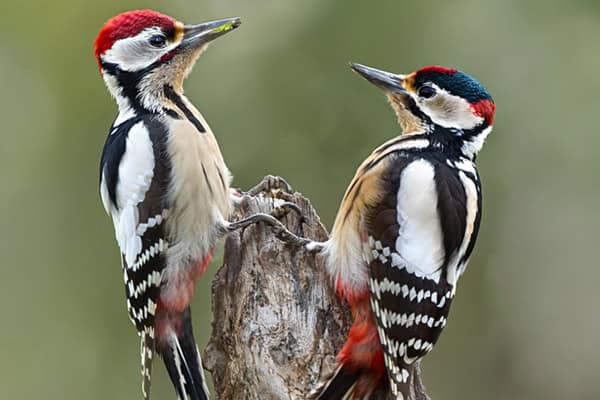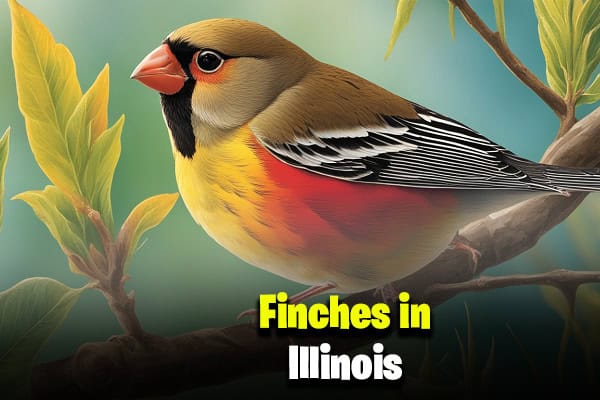12 Types of Woodpeckers in Texas (ID Guide With Pictures)
Woodpeckers are among the most fascinating and unique bird species in Texas. These resilient birds are renowned for their distinctive drumming behavior, vibrant plumage, and crucial role in ecosystems. In Texas, woodpeckers thrive in diverse habitats, ranging from thick forests to arid desert regions. With over 13 species, including some that are common and others that are rare or even endangered, woodpeckers contribute significantly to the health and balance of Texas’ natural environments.
In this article, we’ll explore the diverse woodpecker species in Texas, their habitats, feeding behaviors, conservation efforts, and the best places to observe them in the wild.
What Are Woodpeckers?
Woodpeckers belong to the family Picidae, and they are well-known for their unique behavior of tapping or “drumming” on trees. This behavior serves multiple purposes, such as finding food, creating nests, and communicating with other woodpeckers. One of their defining characteristics is their strong beaks, which they use to peck into wood to extract insects or sap. Additionally, their specially adapted skulls and strong neck muscles help absorb the impact of constant pecking.
In Texas, there is a wide variety of woodpecker species, each contributing uniquely to the state’s ecological balance. Some woodpeckers are common across various regions, while others are rare or possibly extinct.
Importance of Woodpeckers in Texas
Woodpeckers play an essential role in Texas ecosystems. One of their primary contributions is pest control. Many woodpeckers feed on insects such as ants, beetles, and larvae that burrow into trees. By doing so, they help maintain tree health, preventing infestations that could damage forests.
Moreover, woodpeckers contribute to biodiversity. The holes they create in trees become vital habitats for other species, including small mammals, owls, and bats. Without the nesting cavities created by woodpeckers, many species would struggle to find shelter, especially in areas with limited tree cover.
Main Points:
- Texas is home to several unique woodpecker species, each with distinct characteristics.
- Woodpeckers play a crucial role in forest health and biodiversity.
- Their presence is an indicator of a healthy ecosystem.
Types of Woodpeckers in Texas
Texas is home to a variety of woodpeckers, ranging from the large and powerful Pileated Woodpecker to the small and adaptable Downy Woodpecker. Below are some of the most common woodpecker species found in Texas, along with some rare or endangered ones.
Common Species of Woodpeckers in Texas
1. Pileated Woodpecker
- Scientific Name: Dryocopus pileatus
- Size: 38–49 cm (15–19 in)
- Weight: 250–400 g (8.8–14.1 oz)
- Lifespan: Up to 12 years
- Diet: Wood-boring insects, fruits, and nuts.
The Pileated Woodpecker is the largest species found in Texas, easily recognizable due to its striking red crest and loud calls. Known for its powerful drilling behavior, this woodpecker creates large, rectangular holes in trees to forage for insects, particularly carpenter ants. Pileated Woodpeckers prefer mature forests with large trees, often found in East Texas and forested areas near rivers and streams.
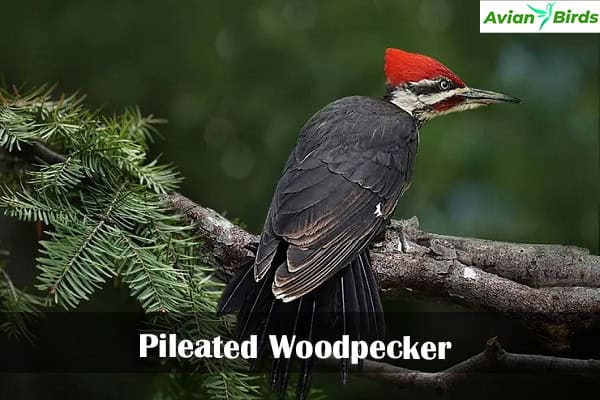
What do Pileated Woodpeckers make sound like?
You Must Read: Woodpeckers Of Ohio
2. Red-bellied Woodpecker
- Scientific Name: Melanerpes carolinus
- Size: 23–25 cm (9–10 in)
- Weight: 70–100 g (2.5–3.5 oz)
- Lifespan: Up to 12 years in the wild
- Diet: Insects, fruits, nuts, and seeds.
The Red-bellied Woodpecker is widespread across Texas. Despite its name, its most noticeable feature is the red cap on its head, along with its zebra-like black and white patterns on the back. It can often be seen clinging to tree trunks or making quick movements up and down branches. This species adapts well to urban settings and is common in parks, gardens, and wooded areas.

3. Downy Woodpecker
- Scientific Name: Picoides pubescens
- Size: 14–19 cm (5.5–7.5 in)
- Weight: 28–90 g (1–3.2 oz)
- Lifespan: Up to 10 years in the wild
- Diet: Insects, larvae, seeds, and berries
The Downy Woodpecker is the smallest woodpecker species in Texas. Its black and white feathers give it a striking appearance, and it is frequently seen in urban areas, particularly in parks and backyards. It is known for its delicate tapping sounds, which are much softer than larger species like the Pileated Woodpecker.

Also Visit: Woodpeckers in Montana
4. Northern Flicker
- Scientific Name: Colaptes auratus
- Size: 30–36 cm (12–14 in)
- Weight: 90–150 g (3.2–5.3 oz)
- Lifespan: Up to 9 years in the wild
- Diet: Primarily ants and beetles, as well as seeds and fruits
The Northern Flicker is unique among woodpeckers because it often feeds on the ground, primarily searching for ants and beetles. This species is easily identified by its spotted belly and yellow-shafted feathers. Northern Flickers are most commonly found in open woodlands, forest edges, and even deserts in Texas.

5. Golden-fronted Woodpecker
- Scientific Name: Melanerpes aurifrons
- Size: 22–25 cm (8.7–9.8 in)
- Weight: 70–90 g (2.5–3.2 oz)
- Lifespan: Up to 10 years in the wild
- Diet: Insects, fruits, seeds, and nuts
As the name suggests, the Golden-fronted Woodpecker is characterized by its bright golden nape. It is commonly found in central and southern Texas, where it inhabits mesquite thickets and open woodlands. Its diet consists of a mix of insects, fruits, and seeds.

6. Red-headed Woodpecker
- Scientific Name: Melanerpes erythrocephalus
- Size: 22–26 cm (8.7–10.2 in)
- Weight: 70–100 g (2.5–3.5 oz)
- Lifespan: Up to 9 years in the wild
- Diet: Insects, fruits, nuts, and seeds
This species is easily identifiable due to its entirely red head and contrasting black and white body. Red-headed Woodpeckers are adept at catching insects in mid-flight and are also known to store food, such as acorns, in tree crevices for later consumption.
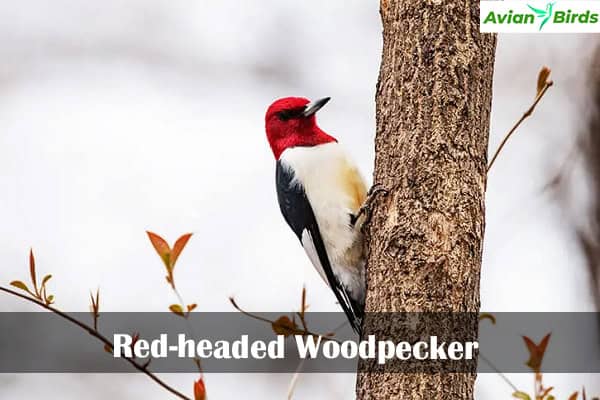
Must Read: Woodpeckers in Missouri
7. Ladder-backed Woodpecker
- Scientific Name: Picoides scalaris
- Size: 18–20 cm (7–8 in)
- Weight: 40–70 g (1.4–2.5 oz)
- Lifespan: Up to 6 years in the wild
- Diet: Insects, especially beetles, as well as seeds and fruits
Common in arid regions of Texas, particularly the western and southern parts of the state, the Ladder-backed Woodpecker is distinctive for its checkered black and white pattern on its back. It is a small, agile woodpecker that thrives in desert habitats and thorn scrub forests.

~Endangered or Rare Woodpecker Species~
8. Ivory-billed Woodpecker (Possibly Extinct)
- Scientific Name: Campephilus principalis
- Size: 46–56 cm (18–22 in)
- Weight: 450–600 g (1.0–1.3 lb)
- Lifespan: Unknown in the wild, but likely several years
- Diet: Primarily wood-boring beetle larvae
The Ivory-billed Woodpecker is one of the most controversial and mysterious woodpeckers in North America. Once thought to be extinct, there have been several unconfirmed sightings in recent years, sparking debate among ornithologists. If still extant, it would be one of the rarest birds in the world. However, there is no concrete evidence to prove its survival.

9. Yellow-Bellied Sapsucker
- Scientific Name: Sphyrapicus varius
- Size: 18–22 cm (7–8.7 in)
- Weight: 50–100 g (1.8–3.5 oz)
- Lifespan: Up to 6 years in the wild
- Diet: Primarily sap from trees, as well as insects and fruits
The Yellow-bellied Sapsucker (Sphyrapicus varius) is a small yet fascinating member of the woodpecker family, known for its unique feeding habits and striking appearance. Found in North America, including parts of Texas during migration, this species plays a crucial role in forest ecosystems by creating sap wells that attract other species. In this guide, we’ll explore the characteristics, behavior, and habitat of the Yellow-bellied Sapsucker, as well as its significance in the broader ecological landscape.

10. Hairy Woodpecker
- Scientific Name: Picoides villosus
- Size: 20–23 cm (7.9–9.1 in)
- Weight: 70–100 g (2.5–3.5 oz)
- Lifespan: Up to 15 years in the wild
- Diet: Insects, especially wood-boring beetles
The Hairy Woodpecker (Picoides villosus) is a medium-sized woodpecker found across North America. It has a distinctive appearance, with a black-and-white plumage, a long bill, and a white belly. Males feature a small red patch on the back of their heads.

11. Northern Flicker
- Scientific Name: Colaptes auratus
- Size: 30–36 cm (12–14 in)
- Weight: 90–150 g (3.2–5.3 oz)
- Lifespan: Up to 9 years in the wild
- Diet: Primarily ants and beetles, as well as seeds and fruits
The Northern Flicker (Colaptes auratus) is a large and distinctive woodpecker commonly found across North America. Unlike many other woodpecker species, flickers often forage on the ground for ants and beetles, making them unique among their relatives.

You Must Read: Woodpeckers in Michigan
12. Acorn Woodpecker
- Scientific Name: Melanerpes formicivorus
- Size: 20–23 cm (7.9–9.1 in)
- Weight: 70–100 g (2.5–3.5 oz)
- Lifespan: Up to 15 years in the wild
- Diet: Primarily acorns, along with insects and fruits
The Acorn Woodpecker (Melanerpes formicivorus) is a striking woodpecker known for its distinctive black and white plumage and bright red cap on males. They are found primarily in western North America, especially in oak woodlands.
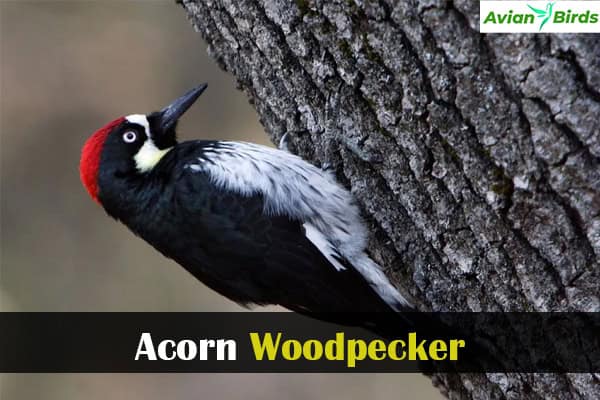
Habitat and Behavior of Texas Woodpeckers
Preferred Habitats of Texas Woodpeckers
Woodpeckers are highly adaptable and can be found in a variety of habitats across Texas. Many species prefer old-growth forests, where large trees provide ample opportunities for nesting and foraging. However, some species, like the Downy Woodpecker and Red-bellied Woodpecker, have adapted well to urban environments, often nesting in parks and suburban gardens.
In contrast, species like the Ladder-backed Woodpecker are more commonly found in the arid regions of West Texas, where they thrive in deserts and thorn scrub ecosystems. Northern Flickers are often seen in open woodlands and along forest edges, where they forage for food on the ground.
Woodpecker Feeding Habits
The diet of woodpeckers in Texas is varied and depends on the species and the availability of food. Most woodpeckers primarily eat insects, with ants, beetles, and larvae being their preferred prey. They use their strong beaks to peck into tree bark to extract insects from within.
In addition to insects, some woodpeckers also consume sap, fruits, and seeds. For instance, the Golden-fronted Woodpecker is known to feed on cactus fruits in desert regions, while the Red-headed Woodpecker often stores acorns and nuts for later consumption.
Woodpecker Nesting Habits
Woodpeckers are renowned for their nesting habits, which involve excavating holes in trees using their strong beaks. These nests are typically used to raise young, but they also provide valuable shelter for other species once abandoned. In Texas, woodpeckers often choose trees with softer wood, such as pines and oaks, for nest building.
Conservation Status and Threats to Texas Woodpeckers
Conservation Status of Various Species
While many woodpecker species in Texas are relatively stable, some face significant threats. For example, the Red-cockaded Woodpecker, once common in the southeastern United States, including parts of Texas, is now listed as endangered. This decline is primarily due to habitat loss and deforestation.
Habitat Loss
Deforestation and urbanization are the two primary threats facing woodpecker populations in Texas. As forests are cleared for agriculture, construction, and development, woodpeckers lose critical nesting sites and foraging grounds. Species that rely on mature forests, like the Pileated Woodpecker, are particularly vulnerable to habitat destruction.
Climate Change
Changes in climate patterns are also affecting woodpecker populations in Texas. Warmer temperatures, altered precipitation patterns, and more frequent extreme weather events can disrupt the availability of food and suitable nesting habitats. Migratory woodpecker species, such as the Northern Flicker, may face challenges in finding adequate stopover sites during their seasonal movements.
Conservation Efforts
Efforts to conserve woodpeckers in Texas are ongoing. The Red-cockaded Woodpecker, for example, is the focus of several conservation initiatives, including habitat restoration and the creation of artificial nesting cavities. The Texas Parks and Wildlife Department, along with organizations like the National Audubon Society and the Cornell Lab of Ornithology, play critical roles in monitoring woodpecker populations and promoting habitat conservation.
Best Places to See Woodpeckers in Texas
Texas offers several prime locations for woodpecker watching, where enthusiasts can observe these remarkable birds in their natural habitats.
- Big Thicket National Preserve: This sprawling preserve in East Texas is home to a variety of woodpecker species, including the Pileated Woodpecker and Red-bellied Woodpecker. The preserve’s diverse habitats provide excellent opportunities for birdwatching.
- Davis Mountains State Park: Located in West Texas, this park offers a chance to spot the Ladder-backed Woodpecker in its arid environment.
- Brazos Bend State Park: Situated near Houston, this park is known for its rich birdlife, including the Downy Woodpecker and Red-headed Woodpecker.
Woodpecker Watching Tips
For the best woodpecker watching experience in Texas, it’s important to go equipped. Binoculars and bird identification apps, such as those provided by the Cornell Lab of Ornithology, can enhance your experience. The early morning hours are typically the best time to observe woodpeckers, as they are most active during this time.
Fun Facts About Woodpeckers of Texas
1. Woodpecker Anatomy
Woodpeckers have several fascinating anatomical adaptations that allow them to perform their signature pecking behavior. Their strong neck muscles, reinforced skulls, and shock-absorbing cartilage between their beak and brain help prevent injury from repetitive impacts.
2. Sounds and Communication
One of the most distinctive characteristics of woodpeckers is their drumming sound, which is used to communicate with other birds, establish territory, and attract mates.
3. Unique Woodpecker Behaviors
In addition to drumming, woodpeckers engage in territorial displays, where they mark their territory by pecking on resonant surfaces, such as metal signs or hollow trees.
Read More🐦Related Articles:
- Kingfisher Bird
- Types Of Hawks
- Biblical Meaning Of Dead Birds
- Can Ducks Eat Cucumber Safely
- Two Birds on a Wire Meaning
- Spiritual Meaning of Dead Birds
FAQs About Texas Woodpeckers
Q1. What is the most common woodpecker in Texas?
The Red-bellied Woodpecker is the most commonly seen woodpecker in Texas, found in various habitats across the state, from woodlands to urban gardens.
Q2. Are there endangered woodpeckers in Texas?
Yes, the Red-cockaded Woodpecker is endangered in Texas due to habitat loss, primarily caused by deforestation.
Q3. What time of year are woodpeckers most active in Texas?
Woodpeckers in Texas are generally active year-round, but the best time to observe their nesting and drumming behavior is during the spring and early summer.
Q4. Can I attract woodpeckers to my backyard in Texas?
Yes, you can attract woodpeckers by providing suet feeders, maintaining dead trees, and offering nesting boxes in your backyard.

